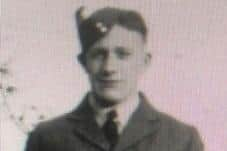Chop Gate bones: Inquest opens into death of World War Two airman in Yorkshire moorland crash whose remains were found in 2020
Warrant Officer Eric Alan Stubbs, 22, was the navigator of a Mosquito aircraft which crashed in Bransdale in the North York Moors in October 1944, killing him and the pilot, Alfred Milne, instantly.
Yet bones belonging to the two airmen were found at a smallholding in the village of Chop Gate, around an hour’s walk away, in the spring of 2020 and a criminal investigation launched.
Advertisement
Hide AdAdvertisement
Hide AdThe RAF conducted a search of the crash site in 1944 and had apparently removed the bodies, which were buried in a cemetery in Surrey with the knowledge of their families.


The inquest opening at North Yorkshire Coroner’s Court in Northallerton on Friday gave Mr Stubbs’ cause of death as ‘unascertained’ but clarified that he died as a result of the impact.
Both his and Mr Milne’s inquests will be resumed and heard in full at a later date.
During the joint North Yorkshire Police and Ministry of Defence investigation, a 74-year-old man was arrested, but no charges were ever brought and the case was closed after a second burial ceremony attended by descendants of both Mr Milne and Mr Stubbs at the cemetery where they were interred in 1944.
Advertisement
Hide AdAdvertisement
Hide AdAppletree Hurst Cottage, where the remains were discovered, was already well-known in aviation circles as the home of Kenneth Ward, a collector of World War Two memorabilia, who lived there until 2011, when he was jailed for harassing a woman living at a neighbouring farm. Although the cottage is in a poor condition and currently uninhabited, the adjoining farmhouse was sold to new owners who discovered the bones.
A large amount of aircraft parts remained on the site after Ward's imprisonment and the MOD has been involved in their dispersal, with many now stored at a secure location.
The airmen's Mosquito was on a secret transit flight between two airfields at the time, carrying a prototype of a ‘bouncing’ bomb. Much of the wreckage was allowed to remain at the site, though some was recovered and donated to museums in 1969 by a preservation society.
